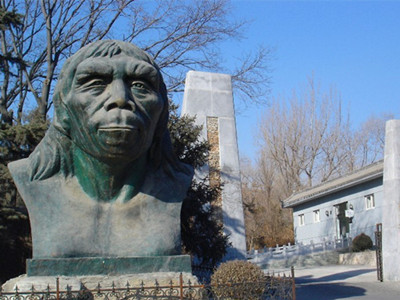Zhoukoudian Peking Man Site [ Related Itinerary ]
 Zhoukoudian Peking Man Site is located 50 kilometers southwest of Beijing city proper. Got the fame of "Home to Peking Man", it is a natural habitat of human ancestors about 700,000 years ago and regarded as the cradle of Chinese civilization.
Zhoukoudian Peking Man Site is located 50 kilometers southwest of Beijing city proper. Got the fame of "Home to Peking Man", it is a natural habitat of human ancestors about 700,000 years ago and regarded as the cradle of Chinese civilization.Eight sites of ancient human remains have been discovered since 1921. 118 kinds of animal fossils and over 100,000 stone wares have been unearthed at the same time. All these discoveries from Zhoukoudian Peking Man Site have conclusively proved that the Peking Man had been distinguished from anthropoid, 500,000 years ago. In 1961, Peking Man Site was listed as one of the First Key National Cultural Protection Units by the State Council. In 1987 it was inscribed in UNESCO World Heritage List.
Three Representative Remains
There are three representative remains exist now: the Peking Man Site, the Upper Cave Man Site and the New Cave Man Site.
In 1921 at Zhoukoudian, a cave was discovered and archaeologists confirmed it as the habitat of Peking Man. In 1929, a complete skullcap fossil was discovered by a Chinese Paleontologist, which could be traced back 500,000 to 700,000 years ago. Proving the existence of Sinanthropus, the discovery caused a great attention around the world. Since then, Zhoukoudian has known as the 'Home of Apeman'.
In 1930, the Upper Cave Man Site was discovered and in 1933 it was excavated. The cave is about 4 meters high and 5 meters wide consist of three complete skullcap fossils and many other fossils including bone needles, animal teeth and the remains of necklaces. According to scientific research, the Upper Cave Man lived about 18,000 years ago.
In 1973, the New Cave Man Site was discovered, 100 meters south to Peking Man Cave. One tooth, fossils of amniotes and other animals were unearthed here. Scientific research proved that the New Cave Man lived 100,000 years ago. The discovery site bridges the gap between Peking Man and Upper Cave Man.
In 1953, the museum was founded and opened to the public. All the cultural relics displayed here are valuable in the study of the origin and evolution of the human species. The remains provide a good opportunity for tourists to explore the primitive life of our ancestors.
Until now, Zhoukoudian Peking Man Site represents the most comprehensively and systematically studied site of Homo erectus and holds the realistic and scientific value. To know more about the cradle of Chinese civilization, come to visit.
Related Itinerary